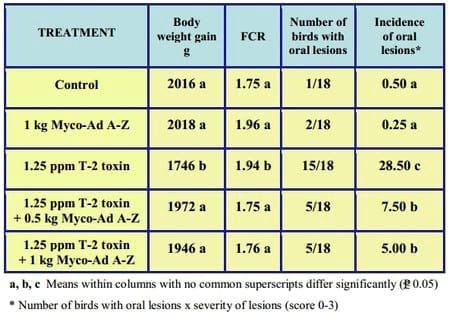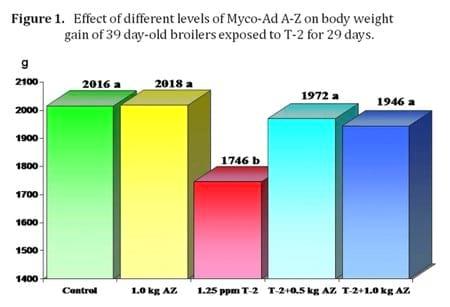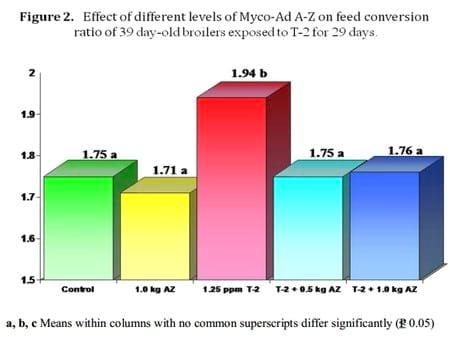Reduce the Toxicity of T-2 Toxin in Broilers
Low Dosage Efficacy of a Commercial Purified Phylosilicate to Reduce the Toxicity of T-2 Toxin in Broilers
Performance and health are both affected when poultry consume feed contaminated with T-2 toxin. (T-2) The dietary use of 0.1% of a commercial purified phylosilicate (Myco-Ad A-Z) has been demonstrated to effectively prevent the toxic effect of T-2 in broilers. An experiment was conducted to confirm previous results and evaluate the efficiency of a lower dose of Myco-Ad A-Z in reducing the deleterious effects of T-2 in broilers. Ninety 10-day-old Ross 308 male broiler chicks individually caged were randomly distributed into five dietary treatments with 18 replications of one chick each. Birds were fed a corn-soybean meal based mash diet containing or exceeding NRC recommended nutrients levels. The feed was experimentally contaminated with synthetic T-2 from Sigma Chemical Company, USA. Treatments were: (1) control diet; (2) control + 1.0 kg/mt Myco-Ad A-Z; (3) control + 1.25 ppm T-2; (4) control + 1.25 ppm T-2 + 0.5 kg/mt Myco-Ad A-Z and (5) control + 1.25 ppm T-2 + 1.0 kg/mt Myco-Ad A-Z. Results at 39 days of age indicated that broilers fed 1.25 ppm T-2 contaminated diet presented significant (P≤0.05) lower body weight, poorer feed conversion, and greater incidence/severity of macroscopic oral lesions than chickens fed the control diet. The highest mortality occurred in broilers fed the T-2 contaminated diet. The addition of either 0.5 or 1.0 kg/mt of Myco-Ad A-Z to the contaminated diet resulted in broilers with statistically significant (P≤0.05) heavier body weight gain (1972 and 1946 v 1746 g); more efficient feed conversion (1.75 and 1.76 v 1.94) and reduced oral lesions incidence/severity than those fed 1.25 ppm T-2. The addition of 1.0 kg/mt of Myco-Ad A-Z to the diets did not show any statistical (P≤0.05) difference in overall performance compared to the control diet, demonstrating its lack of interference with nutrients absorption. These results indicated that Myco-Ad A-Z at the low dosage of 0.5 kg/mt was effective in preventing the toxic effects of T-2 in broilers.
Key Words: Myco-Ad A-Z, T-2 toxin, broilers





2. Myco-Ad A-Z at the low dosage of 0.5 kg per metric ton of feed was effective in preventing the deleterious effects caused by T-2 in broiler chickens.
3. The addition of 1.0 kg of Myco-Ad A-Z per metric ton of feed did not show any statistical difference in overall performance compared to the control diet, demonstrating its lack of interference with nutrients absorption.
2. Casarin, A., M. Forat, E. Soto, and D. Zaviezo. 2006. Evaluation of the efficacy of a commercial purified phylosilicate to reduce the toxicity of T-2 toxin in broiler chicks. Poultry Sci. 85 Suppl.1 pp. 201-202.
3. Hoerr, F.J., 2003. Mycotoxicoses. Pages 1103-1132 in Diseases of Poultry. Ed by I. Saif. 11th ed. Iowa State Press. Ames, Iowa.
4. Leeson, S., G.J. Diaz, and J.D. Summers, 1995. Trichothecenes. Pages 190-226 in Poultry Metabolic Disorders and Mycotoxins. University Books, Guelph, Canada.
5. Medina, J.C., J.A. Fierro, J. Lara, V. Brito, and M. Forat. 2010. The effects of 1.2 ppm T-2 Toxin on performance, lesions, and general health of male broilers and the efficiency of an organoaluminosilicate (mycotoxin binder). Poultry Sci. 89 Suppl. 1 pp 282-283.
6. National Research Council. 1994. Nutrient Requirement for Poultry. 9th rev. ed. National Academy Press. Washington, D.C.
7. Phillips, T.D., B.A. Clement, L.F. Kubena, and R.B. Harvey. 1990. Detection and detoxification of aflatoxins: prevention of aflatoxicosis and aflatoxin residues with hydrated sodium calcium aluminosilicate. Vet. Human Toxicol. 32:15-19.
8. SAS Institute. 2003. SAS/STAT Guide for Personal Computers. Version 9.1 Edition. SAS Institute Inc., Cary, North Carolina.
9. Starkl, V.H. and M. Forat. 2009. The effects of 1.5 ppm T-2 toxin on performance, lesions and general health of male broilers and the efficiency of a mycotoxin deactivator to counteract. Poultry Sci. 88 Suppl. 1 pp 176.
Of course, it's a good way for testing modified phylosilicate in other source of food and feed.
The data about Reduce the Toxicity of T-2 Toxin in Broilers shows inconsitency. One time the FCR with 1kg Mycoad is 1,96 then in the table 1,71? What is true now?











.jpg&w=3840&q=75)